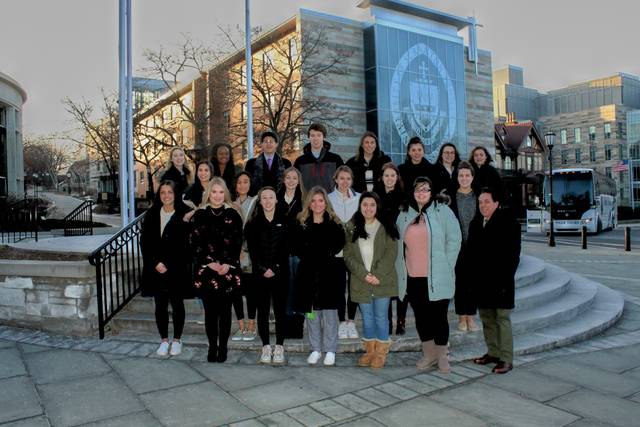TUNKHANNOCK — It has been more than six years since the Wyoming County history mural was imagined on the outside blank wall of the Dietrich Theater. Now, the first of three panels has been installed, thanks to the Wyoming County Room Tax Fund, the Endless Mountains Visitors Bureau and the Endless Mountains Heritage Region with funding from Pennsylvania’s Department of Conservation and Natural Resources. The mural project which is to be comprised of three murals installed over the course of three years has been titled, “Telling Wyoming County’s History” and Bob Lizza of Lizza Studios in Tunkhannock was the artist chosen to depict that history.
The first mural shows Wyoming County’s Tunkhannock Viaduct, also referred to as the Nicholson Bridge. Jean Ruhf, executive director of the Endless Mountains Visitors Bureau, relays with a laugh, “Yes. Now the Tunkhannock Viaduct can be seen not only in Nicholson, but it can be seen right here in downtown Tunkhannock.”
In order to choose the focus for the murals, Erica Rogler, executive director of the Dietrich Theater, formed a committee for the selection. After two meetings, they unanimously agreed that the first two murals should showcase the Tunkhannock Viaduct, the frequently chosen icon of Wyoming County. The subject for third mural on the Bridge Street side of the Dietrich is yet to be determined, but will to be made by the committee.
Serving on the committee are Mark Mitchell, of the Wyoming County Historical Society; Penny Davis, Dietrich Theater board member; John Keker, Dietrich Theater president; Erica Rogler, Dietrich Theater executive director; Margie Young, Dietrich Theater board member; Sandy Vieczorek, Dietrich Theater treasurer; Jean Ruhf, executive director of the Endless Mountains Visitors Bureau; Sara Carr of the Wyoming County Historical Society; Cain Chamberlin, executive director of the Endless Mountains Heritage Region; Sarah Sidorek, Dietrich Theater secretary; Judy Mead, Tom Henry and Mike Stabinsky, Wyoming County commissioners.
Bob’s design was inspired by a postcard from the 1930s and the style of painting he used to make it look like you can walk right into the painted scene is called “trompe l’oeil” or trick of the eye. Using this style allowed him to incorporate some of the architectural elements of historic downtown Tunkhannock into the mural. He painted brickwork that matches the brick on the original portion of the Dietrich and bluestone stairs that mimic those of the Wyoming County Historical Society, which is located just a few blocks away from the theater.
Lizza studied the mural process for the last six years and, during that time, the process has evolved. Murals can be painted directly on the surface of a building, but they can also be painted on a cloth-like material and adhered to the building. In Pittston, Pennsylvania, on North Main Street, one can see an example of a mural using a similar process. This process has served well for urban murals in Philadelphia, Los Angeles and other cities.
After the mural design was revealed, Lizza scanned his original painting and enlarged it onto a grid of 35 poly-tab pieces at full size with a faint black and white image as a guide. Each piece was then hand painted by Lizza to fit together. When the panels were complete, they were applied to the Dietrich’s wall, which was prepared with primed concreted panels to create a perfectly durable and flat outdoor surface. While the painting process took several months, the installation process only took a matter of days.
Years of planning, researching and seeking funding have finally brought the first mural of Telling Wyoming County’s History to the back wall of the Dietrich Theater, thanks to Bob Lizza, the mural committee and volunteers, including Jim Rosengrant, Greg Kissell, Jim Hudock, Seth Goodman, Natalie Lizza Rail, BX3 Supply and Rental and the aforementioned sponsors.





